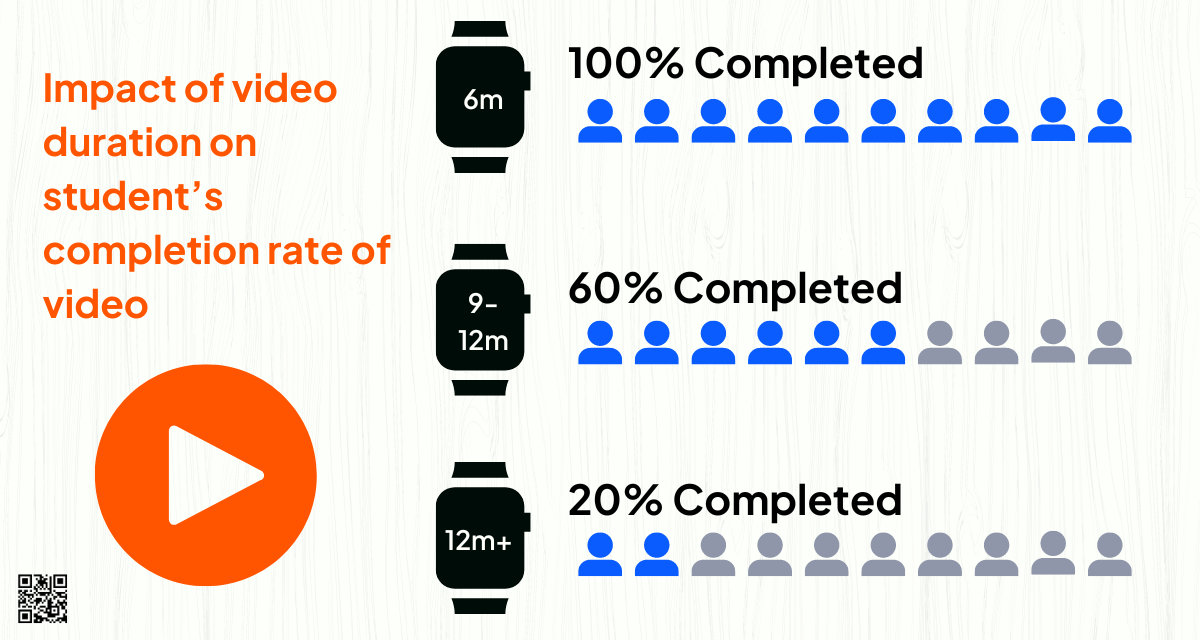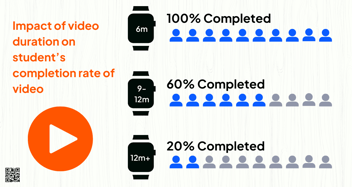It’s no wonder video streaming platforms have become the most used digital tool in classrooms today. [1] Educational videos are one of the most straightforward and accessible ways to incorporate digital media in support of classroom instruction. They function across multiple platforms and are easily accessible for almost any level of student. Educational videos lend themselves to a wide variety of academic applications with the only real limit being the imagination of the instructor. Educational videos within and without the classroom can be cross-curricular, bi-modal, horizontally aligned, and state standards-specific. Some platforms have music and cartoon mascots to make learning a more enjoyable experience.
Educational videos have proven to be astonishingly effective in supporting student engagement and information retention. With educational videos, students self-report greater interest in educational topics and even greater enjoyment in learning. Teachers report greater learning gains in the classroom with students gaining a richer understanding of essential content. When it comes to standardized tests, students see an improvement in their scores thanks to the educational video content they receive.
In one comprehensive study, nearly 100% of students being observed watched videos of 6 minutes or less all the way through. The number dropped only slightly when video lengths were increased to 6 – 9 minutes. Above that, however, the drop-off in completion rates was substantial. Fewer than 60% finished videos between 9 – 12 minutes long; after the 12-minute mark, completion rates plummeted another 2/3 to just over 20%. [2]

Another study sought to understand whether there were observable learning gains for students instructed with short educational videos. Two student populations were instructed with educational video support with one population receiving ~55-minute filmed lectures and the other receiving a series of shorter video clips running at an average of 8 minutes apiece. Not only did the short-video group experience 24.7% higher engagement, but they also scored 9% higher than the long-video group on exams.
Clearly, video length makes a difference.
Short videos for learning
Teachers seem to agree. Around 90% of teachers surveyed say they’re always on the lookout for clips of 10 minutes or less for classroom use. (About 50% preferred videos between 2 – 5 minutes in length.) [3] Shorter videos allow teachers greater flexibility to incorporate media into their lesson plans, supporting rather than replacing them. The use of short educational videos for students offers teachers flexibility unavailable to them a generation ago.
How short educational video clips help teachers be more effective
1. As a means to building interest in the lesson ahead
The most extreme form of this is a fully flipped classroom model, in which students watch assigned videos and/or read prepared materials at home preparation for class the next day. This model essentially replaces homework and inverts its place in the educational process; instead of completing a homework assignment that assesses how well they interalized a lesson, learners are given material to prepare themselves before receiving a lesson. This model can become impractical with longer videos and in that case, fewer students would be likely to arrive prepared for class. Shorter videos allow teachers to most effectively target specific subject matter whether they assign one or several.
In a more traditional classroom, where teachers are perpetually striving to engage students with educational content, an introductory video can “prime the pump,” preparing students for the topic of the day or reminding them of what they already know before moving forward. Ideally, it builds interest as well – an area in which videos have, not surprisingly, proven to be quite effective. Engaging students, priming the pump, building interest; all these goals are easily met with shorter, carefully selected clips. No media, however engaging, can succeed as an attention-builder or lesson preview if it takes half the class period. Educational video in the classroom should support the class period, not supplant or replace it.
2. As a way to reinforce, reframe, and/or re-segment a lesson
I
You may have noticed over the recent decades that there’s an ongoing push towards student-driven activities and personalization. This shifts the educational model away from teacher-centered instruction. While it’s a safe assumption that teachers want to avoid droning an endless litany of facts at a student body that sits passively with glazed-over eyes, there are subjects that need a foundation of substantial content knowledge. It’s not always realistic to hope or assume that students will discover and digest all that knowledge on their own, without guidance. This makes some combination of direct instruction, assigned readings, and content-rich media a necessity for any educator looking to convey the essentials of the subject area or skill set.
Incorporating informative or evocative videos that are short and content-rich can create natural “segments” or “chunks” of engaging instruction that includes different “voices” and points of view. This holistic and inclusive approach leads to a deeper understanding and retention of the information being taught. Short-form educational videos, effective in and of themselves, help segment the lesson and this dynamic makes other forms of direct instruction, application, or review more effective as well.
3. As a way to better prepare students
 It’s not unusual in advanced courses or post-secondary education for students to be expected to arrive in class prepared to move forward with information they’ve been assigned to absorb on their own. Many teachers have discovered that a combination of required reading and required viewing provides a reasonable balance between “high expectations” and the realities of the modern student and their worlds.
It’s not unusual in advanced courses or post-secondary education for students to be expected to arrive in class prepared to move forward with information they’ve been assigned to absorb on their own. Many teachers have discovered that a combination of required reading and required viewing provides a reasonable balance between “high expectations” and the realities of the modern student and their worlds.
For this to be effective, however, teachers need easy access not only to quality textbooks and supplemental readings but an ample supply of reliable, highly engaging videos on a wide range of topics and of manageable lengths for busy students. Even “advanced” or “honors” students have their limits, and the right mix of reading and short-form educational videos offers an accessible pathway for their success.
4. As a way to review and re-teach
I
In advanced courses and post-secondary education, students are usually expected to engage in required reading outside the classroom so that they can be prepared to move forward with the class. Many teachers have discovered that a combination of required reading and required viewing provides an elegant balance between high expectations and the realities of student life today.
For this magic combination to be effective, teachers need quality textbooks and supplemental readings as well as an ample supply of reliable, highly engaging Ed-Ready videos that cover a diverse spectrum of topics while remaining a manageably short length for busy students. For students of all achievement levels, the right mix of reading and short-form educational video content offers an accessible pathway to their success.
Students who require remedial instruction are often the least likely to remain focused on extensive reading or feature-length viewing like with documentaries or filmed lectures. They’re more likely to take on a defeatist “I can’t” mindset in educational spaces due to feeling overwhelmed by content. The struggle to stay focused and the challenge to the attention span often results in these students feeling incapable and shutting down. What these students need is balanced media that’s concise and digestible while remaining content-rich.
When reviewing material, students neither want nor need an exhaustive recitation of everything covered in previous weeks’ instruction. Carefully chosen short-form videos emphasize essential information in a time-efficient manner. Instead of a quantity of information, there’s quality in effective tools and useful options. This could be imagined as a protein bar: portable and small, but densely packed with nutrients and more effective than an hours-long banquet.
Where to find short learning videos for students
Quality educational video content is difficult to locate and utilize consistently. Teachers report the number one obstacle to using more video in the classroom is the time it takes to find effective videos. Too many videos out there are poor quality, contain too little content, have potentially unclear provenance, or are simply not engaging for students or for teachers.
The internet is full of engaging digital videos. Many of them use course language, display imagery inappropriate for a school setting, and traffic in disinformation, a situation being monitored as a global threat. Recognizing the dangers of video platforms like YouTube in the classroom, many schools are limiting teachers' access to the platform—sometimes blocking it altogether.
Quality videos are being made and used around the globe, but it’s quite difficult to find Ed-Ready videos that are high quality, the right length, and engaging all while accomplishing learning objectives.
Boclips Classroom is a YouTube alternative for schools, created by teachers and subject matter experts to open a world of audio and video possibilities. It’s a library of more than 2.2M Ed-Ready videos, that are aligned to common curriculums like NGSS, Common Core, and more. Not only can teachers filter their search by subject and age level but they can specify their desired video duration to keep content at an effective length. This way, teachers can optimize the lesson at hand while making the best use of their limited lesson-planning time. If the video they want is still too long, the shareable playback feature allows teachers to share only the relevant section of the video with their students.
When it comes to the length of educational videos, Boclips knows that less is more. Try Boclips Classroom free for 60 days to find out how Boclips can take educational videos from a slog to a snap.
NOTES
1. Vega, V., & Robb, M. B. (2019). The Common Sense Census: Inside the 21st-century classroom. San Francisco, CA: Common Sense Media. Retrieved on February 6, 2020 from https://www.commonsensemedia.org/sites/default/files/uploads/research/2019-educator-census-inside-the-21st-century-classroom_1.pdf.
2. Guo, Philip & Kim, Juho & Rubin, Rob. (2014). How video production affects student engagement: An empirical study of MOOC videos. 41-50. 10.1145/2556325.2566239.
3. Boclips (2019). Access Denied: Teachers Struggle to Access Safe Video Content. Retrieved on February 6, 2020 from https://www.boclips.com/lp-access-denied-one-pager
Boclips
Boclips is on a mission to make learning more captivating with video with an easier, safer way to access videos from the world’s leading video producers.
- #Classroom
- #Video in Digital Learning
- #Educational Videos
- #Tips for Using Video
- #Video Content Partners
- #Boclips for Publishers
- #Issues in Education
- #Educational Videos by Subject Area
- #News and Announcements
- #Events & Holidays
- #Video and Teaching Tools
- #Teaching Methodologies
- #Education Videos
- #Video and Digital Literacy
- #Short Educational Videos
- #Instructional Design
- #Multimodal Learning
- #Video and Student Safety
- #Accessibility in Education
-3.png?width=390&height=223&name=Untitled%20design%20(2)-3.png)


.png?width=1152&height=660&name=Copy%20of%20Untitled%20Design%20(1).png)



